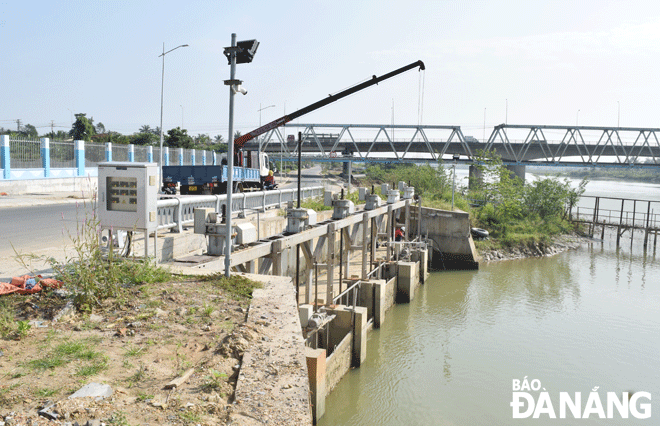Da Nang takes measures to ensure smooth water supply during upcoming scorching summer days
Da Nang’s functional units have implemented many feasible solutions to ensure tap water supplies for the entire city during this year's summer with scorching days expected. This is an urgent must-do amidst the growing number of solar energy systems, the decrease in water flows into reservoirs, downstream rivers and streams, and more tourists tending to return to the city, all of which are driving the demand for water higher.
 |
| Da Nang has implemented many solutions to ensure water supplies citywide during the scorching season. The Da Nang Water Supply Joint Stock Company (DAWACO) has invested in a system of gates to collect fresh water on the surface of Cam Le River to cope with saline intrusion. Photo: HOANG HIEP |
As per the proposal made by Da Nang, the Quang Nam Province People's Committee has agreed with the building of a 31.5m long, 6m wide temporary water dam with sandbags to height of 3.2m on the Quang Hue River which runs through the province’s Dai Loc District, in order to help reduce in the salinity levels of the Da Nang-based Cau Do (Red Bridge) River.
In particular, the Quang Nam administration also urged the Da Nang Water Supply Joint Stock Company (DAWACO), the project developer, to take a solution to protect the downstream of the dam and dismantle it before this year’s rainy season.
The building of the temporary water dam is a must-do as Da Nang sometimes face significant risk of severe drought, salinity intrusion and water shortage in the coming time, especially during the peak period of summer season.
Simply put, such a dam aims to increase the water flow discharged into to the Vu Gia River, thus contributing to ensure water supplies for pumping stations of Dai Loc and Dien Ban areas of Quang Nam Province, and reduce saline intrusion at the intake of raw water into the Cau Do water plant.
Also, the dam helps ensure that the majority of the water sourced from the Vu Gia River will be released into the Yen River where the Da Nang’s An Trach Dam is located. The Da Nang Water Supply Company (DAWACO) has taken the initiative to source water from the An Trach Dam to ensure the delivery of adequate tap water for homes and businesses across the city.
As reported by DAWACO General Director Ho Minh Nam, currently, water from upstream to the An Trach Dam and Cam Le River is abundant, so there has not been any saline intrusion.
DAWACO is ready to operate An Trach anti-salinity Pumping Station to supply fresh water to Cau Do and Airport wate plants for production in case the water source from Cam Le River is seriously contaminated with salinity.
In mid-March, the company will implement a project to increase the capacity of An Trach anti-salinity pumping station from 210,000m3 to 420,000m3 and install the raw water pipelines from the An Trach Dam to the Cau Do water plant.
As planned, the daily capacity of Cau Do Water Plant will be raised from 290,000m3 to 390,000m3 after 2025.
As for the first stage of the under-construction Hoa Lien Water Plant project in Hoa Vang District, the pumping station works, water treatment systems have so far been completed.
This work is of special significance in ensuring clean water supplies for homes and businesses in Da Nang, especially for urban areas, residential areas in the northwestern part of the city, and the Da Nang High-Tech Park, hereby helping ensure the long-term water security in the city.
The first stage of the project, with a daily water supply capacity of 120,000m3, features the building of a 13,606m2 reinforced concrete dam on the Cu De River, and a 727m2 raw water pumping station.
Besides, there are mixing, reaction, sedimentation, filtration, storage, sludge compression and chlorine tanks, a polymer mixer, storage houses, warehouses, security houses, and a parking area.
As schedule, the second stage of the project will target at increasing the plant’s daily water supply capacity to 240,000 m3, thus meeting the city’s development requirements.
Reporting by HOANG HIEP- Translating by A.THU